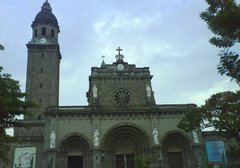Nora was a nurse by profession. She went to work in Saudi Arabia to earn more money to send their children to college. This was difficult for her family and especially for her husband, Jayme. Often, he told me, he was tempted to go to another women but one thing saved him. There was a large picture of Nora in their sala. When he felt tempted he would gaze at it, sometimes he would even take it down and hug it. This is what kept him faithful during those few years.
Today, as we celebrate the feast of the Santo Niño we find ourselves coming back to reflect on the place of images in Roman Catholic teaching. There is no doubt that devotion to images, particularly to those of the Santo Niño and of the Blessed Virgin, have done much to preserve the Faith of the Filipino people. In times when the official Church teaching kept God far from the people - they had little access to the Scriptures and a liturgy in Latin performed facing the wall - the people expressed their genuine faith instinct that God was close through their devotion to images. Just as the picture of Nora brought her close for Jayme, so our images bring God, and his friends and relatives who are perceived as intermediaries with him, close to us. But there is a difference. The picture of Nora helped Jayme to live out the attitudes and values consistent with his love for her. Do our religious devotions lead us to a way of living that is mature and consistent with the faith that we profess?
We find three stages of spiritual growth in the New Testament. The writers were trying to answer the question: "Who was this man Jesus who rose from the dead?" The first memories were of the extraordinary happenings. Jesus had worked miracles of healing and feeding and bringing back life. These stories probably grew as they were passed down by word of mouth. Jesus is recorded, however, as playing down the miracles, of asking people who were cured not to tell others about what happened. He wanted people to come to him for more than the physical healing that they could get from him. The second level of spiritual growth concerns the attitudes that he taught. He taught love and forgiveness towards all, even for one's enemies. St. Paul referred to this second stage as finding the fruits of the Spirit - kindness, gentleness, self-control, forgiveness, by which the inner person is changed. Then as a result of the fruits of the Spirit we move into the third stage, we discover that our value system has changed. We no longer seek power, prestige and possessions. Rather, we see the blessedness of poverty, weakness etc. We accept the values of the Beatitudes: a profound reversal of conventional values.
As we mature spiritually God is no longer sought in the extraordinary but found in the ordinary. To see God is not to see anything different but to see everything differently. The Church's role is to help Christianity mature. We look back into our cultural roots to integrate and transcend what went before. Prayer moves from merely asking God for what we need to being with God in the silence of meditation, in perfect trust that in his love he will do what is best for us.
There is a certain danger in the image of the Santo Niño. It portrays Christ as a child dressed as an adult. It could be seeking the best of two worlds - the protection of a divine king on the one hand, but then he is only a child and can be ignored when he makes difficult demands on our behavior.
In the ceremony of Baptism we place a white cloth on the baptized child as a symbol of its purity and innocence. I always do it with a certain pity for the child who will in a very short time be contaminated by us adults who like to make symbolic gestures but rarely live up to the values they express or the attitudes that they demand.



